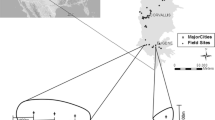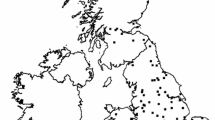Summary
It has been proposed that within rather broad habitat types the distribution and abundance of bird species may be more closely associated with plant taxonomic composition than with the structure and configuration of the vegetation. Birds from a sample of eight representative grassland habitats in middle and western North America are consistent with this hypothesis. Over half (55%) of the variation in bird community composition was associated with floristic variation, but only a third (35%) was associated with physiognomy. Separating the interacting effects of floristics and physiognomy from each other served to accentuate the difference between them with respect to the avifauna. It is postulated that bird species/plant taxa associations, especially within similar habitat types, are mediated by the specific food resources that different plant taxa provide. Summary indices such as diversity measures obscure the taxonomic information content of plant or animal assemblages, and the use of such indices has likely impeded detection of the relationships described here.
Similar content being viewed by others
References
Abbot I (1976) Comparisons of habitat structure and plant, arthropod, and bird diversity between mainland and island sites near Perth, Western Australia. Austral J Ecol 1:275–280
Anderson SH, Shugart HH (1974) Habitat selection of breeding birds in an east Tennessee deciduous forest. Ecology 55:828–837
Asherin DA, Short HL, Roelle JE (1979) Regional evaluation of wildlife habitat quality using rapid assessment methodologies. Trans N Am Wildl Nat Res Conf 44:404–424
Balda RP (1975) Vegetation structure and breeding bird diversity. In: Smith DR (ed) Proceedings of the symposium on management of forest and range habitats for non-game birds. US Forest Service, General Technical Report WO-1, Washington DC, pp 59–80
Bureau of Land Management (1973) BLM Manual 1603-Supplemental Guidance. US Department of the Interior, Release 1–835, Washington DC
Cody ML (1975) Towards a theory of continental species diversities: bird species distributions over Mediterranean habitat gradients. In: Cody ML and Diamond JM (eds) Ecology and Evolution of Communities, Belknap Press, Cambridge, Massachusetts, pp 214–257
Douglas ME, Endler JA (1982) Quantitative matrix comparisons in ecological and evolutionary investigations. J Theor Biol 99:777–795
French NR (coordinator) (1970) Field data collection procedures for the comprehensive network, 1970 season. US IBP Grassland Biome Technical Report 35, Colorado State University, Ft Collins, Colorado.
Grant WE (1971) Site comparisons of aboveground plant biomass, 1970 season. US IBP Grassland Biome Technical Report 83, Colorado State University, Ft Collins, Colorado
Hildén O (1965) Habitat selection in birds. Ann Zool Fenn 2:53–75
Holmes RT, Bonney RE, Pacala SW (1979) Guid structure of the Hubbard Broo, bird community: a multivariate apprach. Ecology 60:512–520
Holmes RT, Robinson SK (1981) Tree species preference of foraging insectivorous birds in a northern hardwoods forest. Oecologia (Berlin) 48:31–35
Horn HS (1966) Measurement of “overlap” in comparative ecological studies. Am Nat 100:419–424
James FC (1971) Ordinations of habitat relationships among breeding birds, Wilson Bull 83:215–236
James FC, Rathbun S (1981) Rarefaction, relative abundance, and diversity of avian communities Auk 98:785–800
James FC, Wamer ND (1982) Relationships between temperate forest bird communities and vegetation structure. Ecology 63:159–171
Karr JR (1971) Structure of avian communities in selected Panama and Illinois habitats. Ecol Monogr 41:207–233
Lovejoy TE (1974) Bird diversity and abundance in Amazon forest communities. Living Bird 13:127–191
MacArthur RW, MacArthur JW (1961) On bird species diversity. Ecology 42:594–598
MacArthur RW, Recher H, Cody ML (1966) On the relation between habitat selection and species diversity. Am Nat 100:319–332
Maurer BA, Whitmore RC (1981) Foraging of five bird species in two forests with different vegetation structure. Wilson Bull 93:478–490
Peet RK (1974) The measurement of species diversity. Ann Rev Ecol Syst 5:285–307
Power DM (1975) Similarity among avifaunas of the Galapagos Islands. Ecology 56:616–626
Rice JC, Ohmart RD, Anderson BS (1983) Habitat selection attributes of an avian community: a discriminant analysis investigation. Ecol Monogr 53:263–290
Robinson SK, Holmes RT (1984) Effects of plant species and foliage structure on the foraging behavior of forest birds. Auk 101:672–684
Rotenberry JT, Wiens JA (1980a) Habitat structure, patchiness, and avian communities in North American steppe vegetation: a multivariate analysis. Ecology 61:1228–1250
Rotenberry JT, Wiens JA (1980b) Temporal variation in habitat structure and shrubsteppe bird dynamics. Oecologia (Berlin) 47:1–9
Schoener TW (1971) Large-billed insectivorous birds: a precipitous diversity gradient. Condor 73:154–161
Sims PL, Singh JW, Lauenroth WK (1978) The structure and function of ten western North American grasslands I. Abiotic and vegetational characteristics. J Ecol 66:251–285
Smith KG (1977) Distribution of summer birds along a forest moisture gradient in an Ozark watershed. Ecology 58:810–819
Snow BK, Snow DW (1971) The feeding ecology of tanagers and honeycreepers in Trinidad. Auk 88:291–322
Sokal RR, Sneath PHA (1963) Principles of numerical taxonomy. W.H. Freeman, San Francisco, California
Thorndike RM (1978) Correlational procedures for research. Gardner Press, New York, New York
Tomoff CW (1974) Avian species diversity in desert scrub. Ecology 55:396–403
Whittaker RH (1975) Communities and ecosystems. Macmillan, New York, New York
Wiens JA (1969) An approach to the study of ecological relationships among grassland birds. Ornithol Monogr 8:1–93
Wiens JA (1971) Pattern and process in grassland bird communities. In: French NR (ed) Preliminary Analysis of Structure and Function in Grasslands, Range Science Department, Science Series 10. Colorado State University, Ft Collins, Colorado, pp 147–211
Wiens JA (1974) Pattern and process in grassland bird communities Ecol Monogr 43:237–270
Wiens JA (1974) Habitat heterogeneity and avian community structure in North American grasslands. Am Midl Nat 91:195–213
Wiens JA, Rotenberry JT (1981) Habitat associations and community structure of birds in shrubsteppe environments. Ecol Monogr 51:21–41
Willson MF (1974) Avian community organization and habitat structure. Ecology 55:1017–1029
Author information
Authors and Affiliations
Rights and permissions
About this article
Cite this article
Rotenberry, J.T. The role of habitat in avian community composition: physiognomy or floristics?. Oecologia 67, 213–217 (1985). https://doi.org/10.1007/BF00384286
Received:
Issue Date:
DOI: https://doi.org/10.1007/BF00384286




